Effect of Cold Rolling on the Microstructural Evolution and Mechanical Properties of Fe-25Mn-3Si-3Al-0.3Nb TWIP Steel
Abstract
:1. Introduction
2. Experimental Procedures
3. Results
3.1. Microstructure
3.2. Mechanical Properties and Static Tensile Fractography
4. Discussion
5. Conclusions
- (1)
- In addition to dislocation slipping, the twinning mechanism still plays a key role during plastic deformation of Fe-25Mn-3Si-3Al-0.3Nb steel at room temperature. The addition of niobium will not significantly change the plasticity mechanism of Fe-25Mn-3Si-3Al steel given that the existing forms and relative content of carbon and niobium in the steel are well controlled.
- (2)
- As the cold rolling strain increases from 30% to 70%, the Fe-25Mn-3Si-3Al-0.3Nb steel undergoes a microstructural evolution process of generating dense dislocations, deformation twins, shear bands and an ultrafine sub-grain structure in that order.
- (3)
- The strength and hardness of Fe-25Mn-3Si-3Al-0.3Nb steel increases clearly with the increasing of rolling strain, and the ductility decreases greatly, but the fracture mechanism of the static tensile specimens with different rolling strains is always microporous aggregate fracturing.
Author Contributions
Funding
Institutional Review Board Statement
Informed Consent Statement
Data Availability Statement
Conflicts of Interest
References
- Seibi, A.C.; Al-Hiddabi, S.; Pervez, T. Structural behavior of a solid tubular undef large radial plastic expansion. J. Energy Resour. Technol. 2005, 127, 323–327. [Google Scholar] [CrossRef]
- Pervez, T.; Qamar, S.Z.; Seibi, A.C.; Al-Jahwari, F.K. Use of SET in cased and open holes: Comparison between aluminum and steel. Mater. Des. 2008, 29, 811–817. [Google Scholar] [CrossRef]
- Grässel, O.; Krüger, L.; Frommeyer, G.; Meyer, L.W. High strength Fe-Mn-(Al, Si) TRIP/TWIP steels development-properties-application. Int. J. Plast. 2000, 16, 1391–1409. [Google Scholar] [CrossRef]
- Bouaziz, O.; Allain, S.; Scott, C.P.; Cugy, P.; Barbier, D. High manganese austenitic twinning induced plasticity steels: A review of the microstructure properties relationships. Curr. Opin. Solid State Mater. Sci. 2011, 15, 141–168. [Google Scholar] [CrossRef]
- Park, G.; Jeong, S.; Kang, H.; Lee, C. Improvement of circumferential ductility by reducing discontinuities in a high-Mn TWIP steel weldment. Mater. Charact. 2018, 139, 293–302. [Google Scholar] [CrossRef]
- Huang, J.X.; Ye, X.N.; Xu, Z. Effect of cold rolling on microstructure and mechanical properties of AISI 301LN metastable austenitic stainless steel. J. Iron Steel Res. Int. 2012, 19, 59–63. [Google Scholar] [CrossRef]
- Morikawa, T.; Higashida, K. The role of deformation twinning in the formation of a fine-grained structure in cold-rolled 310 steel. J. Mater. Sci. 2006, 41, 2581–2585. [Google Scholar] [CrossRef]
- Eskandari, M.; Najafizadeh, A.; Kermanpur, A. Effect of strain-induced martensite on the formation of nanocrystalline 316L stainless steel after cold rolling and annealing. Mater. Sci. Eng. A 2009, 519, 46–50. [Google Scholar] [CrossRef]
- Roy, B.; Kumar, R.; Das, J. Effect of cryorolling on the microstructure and tensile properties of bulk nano-austenitic stainless steel. Mater. Sci. Eng. A 2015, 631, 241–247. [Google Scholar] [CrossRef]
- Li, D.J.; Feng, Y.R.; Song, S.Y.; Liu, Q.; Bai, Q.; Wu, G.; Lv, N.; Ren, F.Z. Influence of Nb-microalloying on microstructure and mechanical properties of Fe-25Mn-3Si-3Al TWIP steel. Mater. Des. 2015, 84, 238–244. [Google Scholar] [CrossRef]
- Huang, B.X.; Wang, X.D.; Rong, Y.H.; Wang, L.; Jin, L. Mechanical behavior and martensitic transformation of an Fe-Mn-Si-Al-Nb alloy. Mater. Sci. Eng. A 2006, 438–440, 306–311. [Google Scholar] [CrossRef]
- Karlsen, W.; Dyck, S.V. The effect of prior cold-work on the deformation behaviour of neutron irradiated AISI 304 austenitic stainless steel. J. Nucl. Mater. 2010, 406, 127–137. [Google Scholar] [CrossRef]
- Kumar, R.; Dasharath, S.M.; Kang, P.C.; Koch, C.C.; Mula, S. Enhancement of mechanical properties of low stacking fault energy brass processed by cryorolling followed by short-annealing. Mater. Des. 2015, 67, 637–643. [Google Scholar] [CrossRef]
- Beladi, H.; Timokhina, I.B.; Estrin, Y.; Kim, J.; De Cooman, B.C.; Kim, S.K. Orientation dependence of twinning and strain hardening behaviour of a high manganese twinning induced plasticity steel with polycrystalline structure. Acta Mater. 2011, 59, 7787–7799. [Google Scholar] [CrossRef]
- Xiong, Y.; He, T.T.; Wang, J.B.; Lu, Y.; Chen, L.F.; Ren, F.Z.; Liu, Y.L.; Volinsky, A.A. Cryorolling effect on microstructure and mechanical properties of Fe-25Cr-20Ni austenitic stainless steel. Mater. Des. 2015, 88, 398–405. [Google Scholar] [CrossRef]
- Kusakin, P.; Belyakov, A.; Haase, C.; Kaibyshev, R.; Molodov, D.A. Microstructure evolution and strengthening mechanisms of Fe-23Mn-0.3C-1.5Al TWIP steel during cold rolling. Mater. Sci. Eng. A 2014, 617, 52–60. [Google Scholar] [CrossRef]
- Lu, K.; Hansen, N. Structural refinement and deformation mechanisms in nanostructured metals. Scr. Mater. 2009, 60, 1033–1038. [Google Scholar] [CrossRef]
- Hong, C.S.; Tao, N.R.; Huang, X.; Lu, K. Nucleation and thickening of shear bands in nano-scale twin/matrix lamellae of a Cu-Al alloy processed by dynamic plastic deformation. Acta Mater. 2010, 58, 3103–3116. [Google Scholar] [CrossRef]
- Tao, N.R.; Zhang, H.W.; Lu, H.; Lu, K. Development of nanostructures in metallic materials with low stacking fault energies during surface mechanical attrition treatment (SMAT). Mater. Trans. 2003, 44, 1919–1925. [Google Scholar] [CrossRef] [Green Version]
- Tao, N.R.; Wu, X.L.; Sui, M.L.; Lu, J.; Lu, K. Grain refinement at the nanoscale via mechanical twinning and dislocation interaction in a nickel-based alloy. J. Mater. Res. 2004, 19, 1623–1629. [Google Scholar] [CrossRef] [Green Version]
- Yu, W.X.; Liu, B.X.; He, J.N.; Chen, C.X.; Fang, W.; Yin, F.X. Microstructure characteristics, strengthening and toughening mechanism of rolled and aged multilayer TWIP/maraging steels. Mater. Sci. Eng. A 2019, 767, 138426. [Google Scholar] [CrossRef]
- Moshtaghi, M.; Safyari, M. Effect of work-hardening mechanisms in asymmetrically cyclic-loaded austenitic stainless steels on low-cycle and high-cycle fatigue behavior. Steel Res. Int. 2021, 92, 2000242. [Google Scholar] [CrossRef]
- Dini, G.; Najafizadeh, A.; Ueji, R.; Monir-Vaghefi, S.M. Tensile deformation behavior of high manganese austenitic steel: The role of grain size. Mater. Des. 2010, 31, 3395–3402. [Google Scholar] [CrossRef]
- Gutierrez-Urrutia, I.; Raabe, D. Multistage strain hardening through dislocation substructure and twinning in a high strength and ductile weight-reduced Fe-Mn-Al-C steel. Acta Mater. 2012, 60, 5791–5802. [Google Scholar] [CrossRef]
- Steinmetz, D.R.; Japel, T.; Wietbrock, B.; Eisenlohr, P.; Gutierrez-Urrutia, I.; Saeed-Akbari, A.; Hickel, T.; Roters, F.; Raabe, D. Revealing the strain-hardening behavior of twinning-induced plasticity steels: Theory, simulations, experiments. Acta Mater. 2013, 61, 494–510. [Google Scholar] [CrossRef]
- Barbier, D.; Gey, N.; Allain, S.; Bozzolo, N.; Humbert, M. Analysis of the tensile behavior of a TWIP steel based on the texture and microstructure evolutions. Mater. Sci. Eng. A 2009, 500, 196–206. [Google Scholar] [CrossRef] [Green Version]
- Etemad, A.; Dini, G.; Schwarz, S. Accumulative roll bonding (ARB)-processed high-manganese twinning induced plasticity (TWIP) steel with extraordinary strength and reasonable ductility. Mater. Sci. Eng. A 2019, 742, 27–32. [Google Scholar] [CrossRef]
- Allain, S.; Chateau, J.P.; Bouaziz, O. Correlations between the calculated stacking fault energy and the plasticity mechanism in Fe–Mn–C alloy. Mater. Sci. Eng. A 2004, 387, 158–162. [Google Scholar] [CrossRef]
- Meng, F.M.; Fu, J.Y. Modern Stainless Steel Containing Niobium, 1st ed.; Metallurgy Industry Press: Beijing, China, 2004. (In Chinese) [Google Scholar]
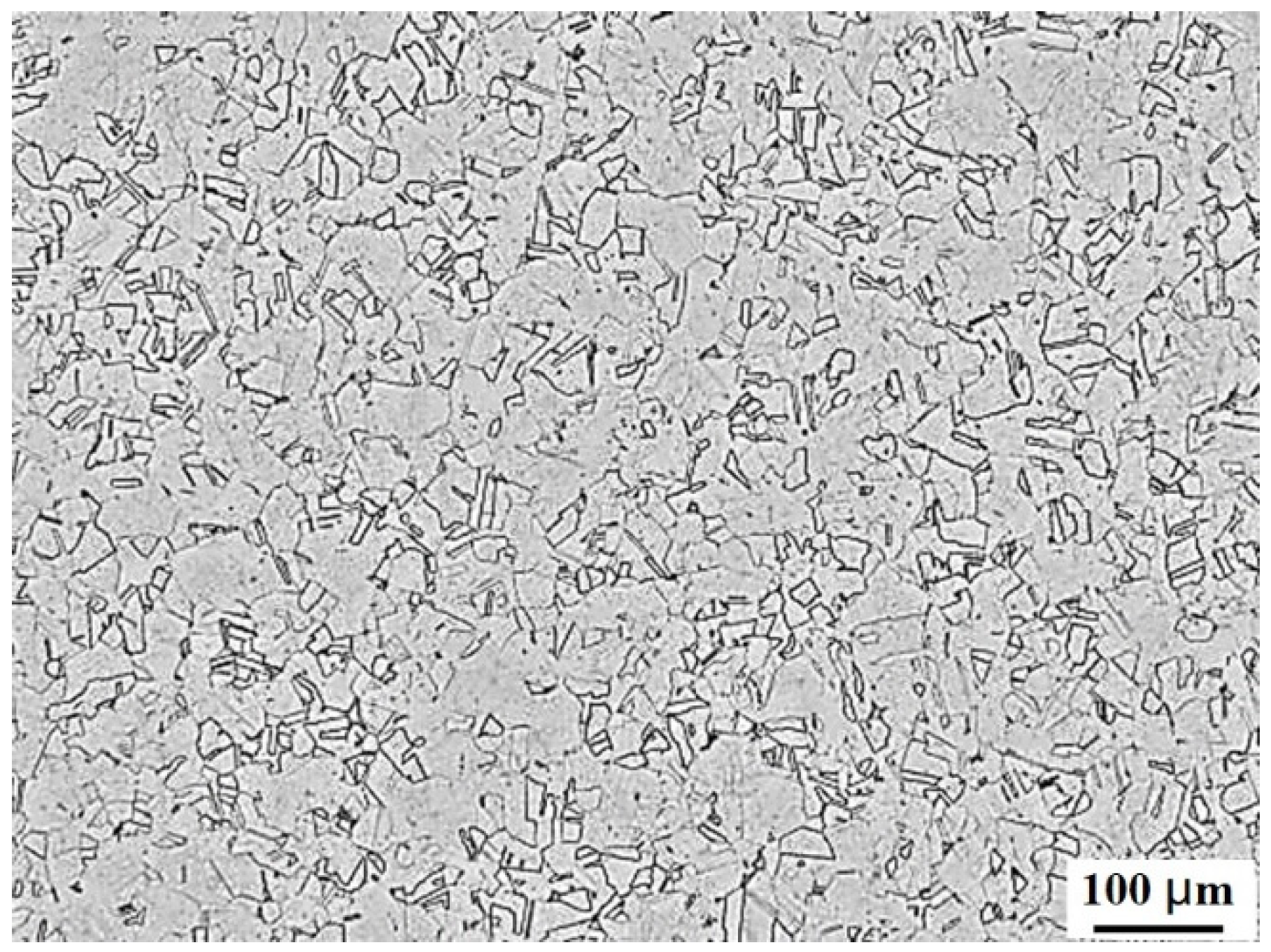

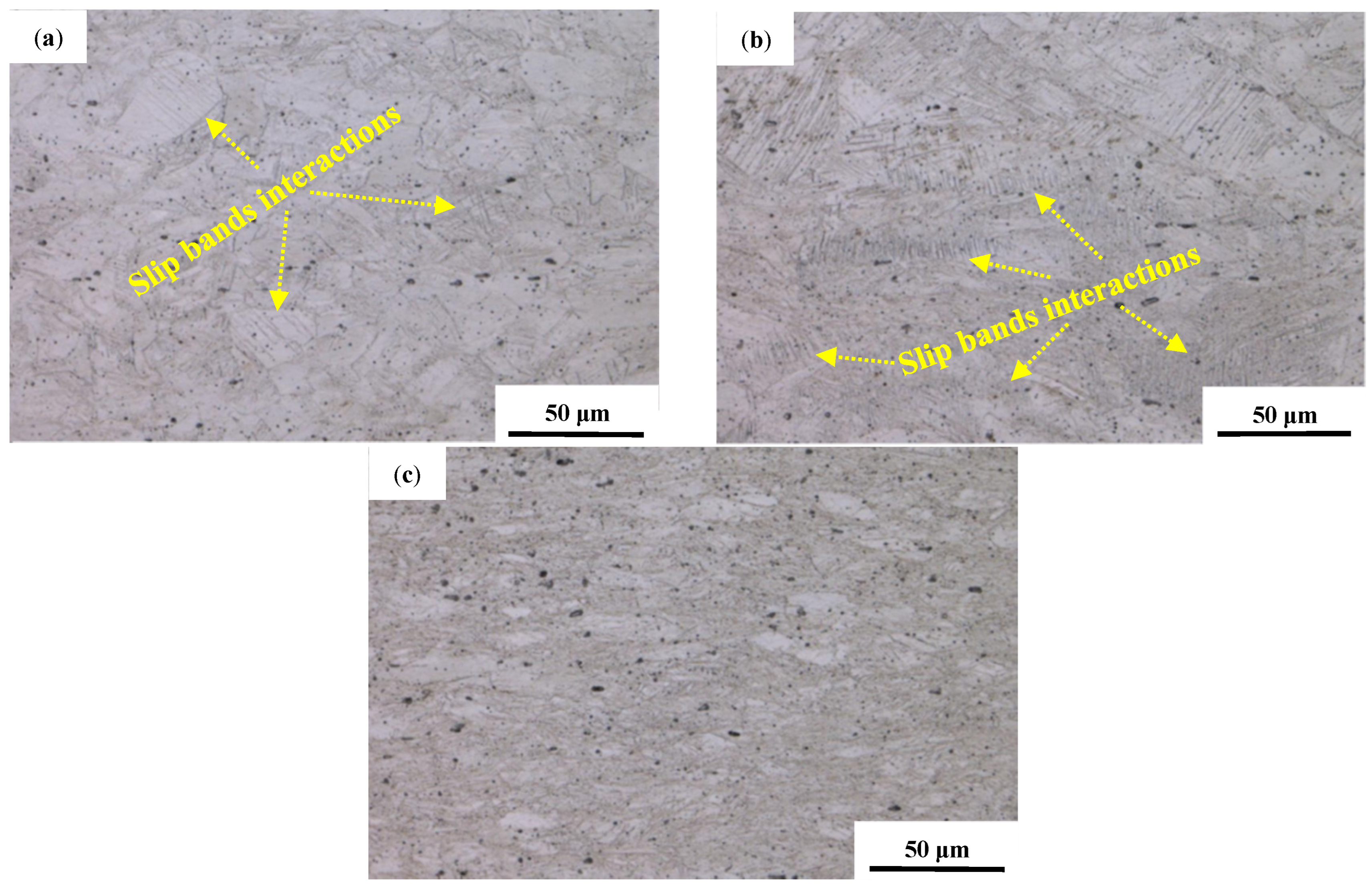


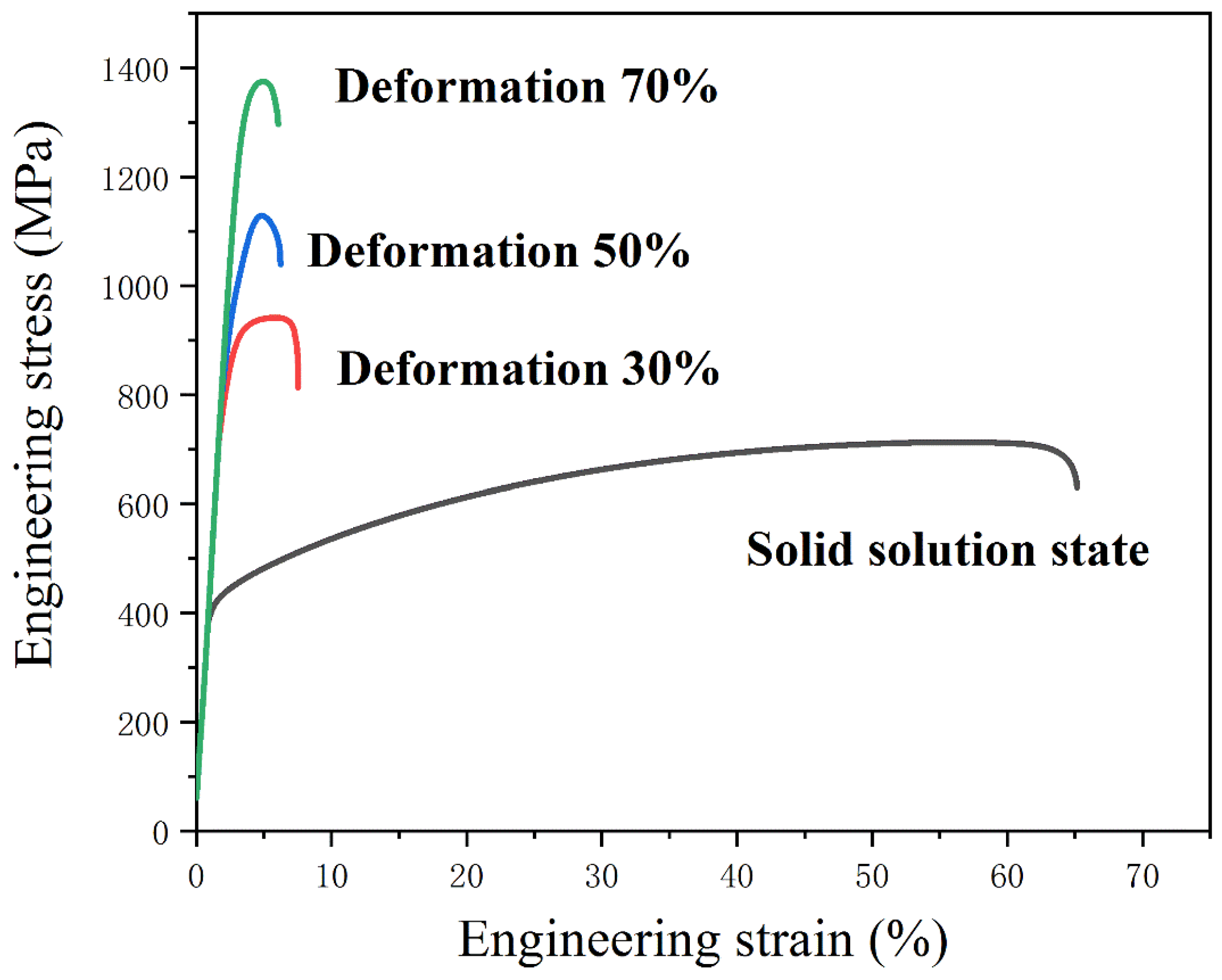
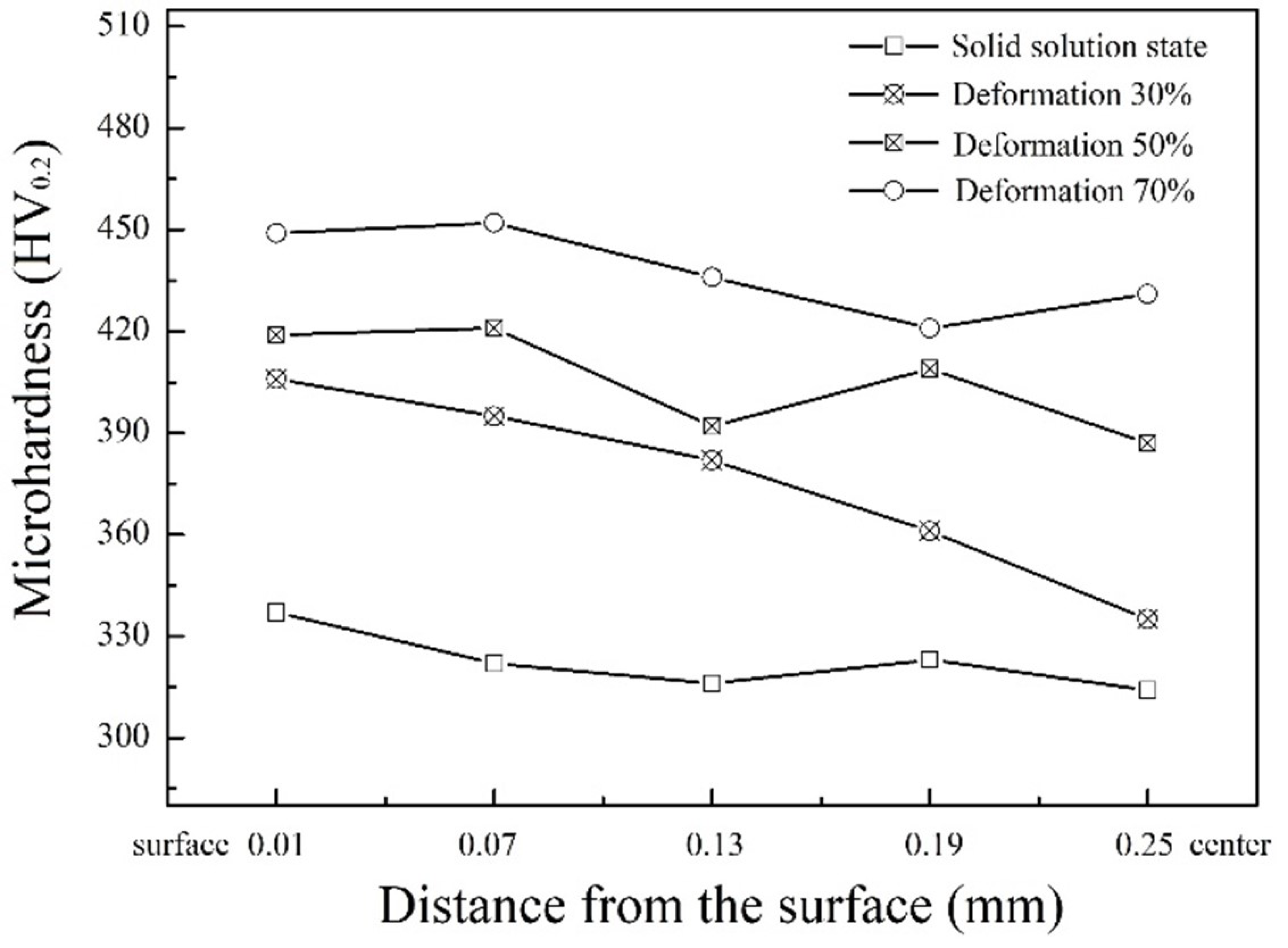
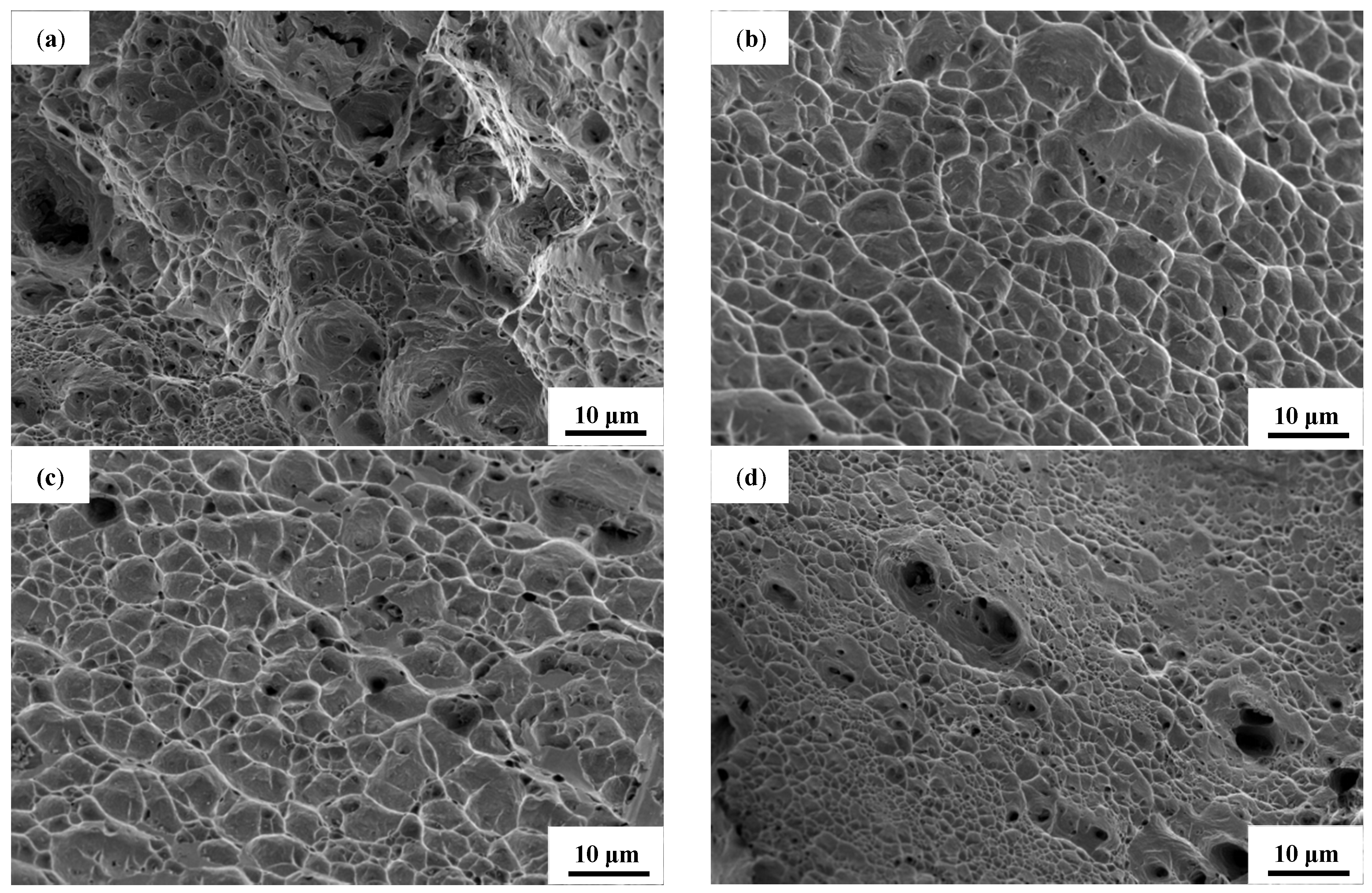

| Element | C | Mn | Si | Al | Nb | P | S | Fe |
|---|---|---|---|---|---|---|---|---|
| [wt.%] | 0.08 | 24.92 | 2.8 | 2.82 | 0.28 | 0.003 | 0.001 | Bal. |
| Rolling Strain | Yield Strength MPa | Tensile Strength MPa | Elongation % |
|---|---|---|---|
| 0% | 418 | 713 | 65.2 |
| 30% | 862 | 942 | 9.1 |
| 50% | 904 | 1128 | 6.2 |
| 70% | 1336 | 1368 | 6.0 |
Publisher’s Note: MDPI stays neutral with regard to jurisdictional claims in published maps and institutional affiliations. |
© 2022 by the authors. Licensee MDPI, Basel, Switzerland. This article is an open access article distributed under the terms and conditions of the Creative Commons Attribution (CC BY) license (https://creativecommons.org/licenses/by/4.0/).
Share and Cite
Li, D.; Guo, J.; He, F.; Feng, Y.; Guo, D.; Ren, F.; Cao, F.; Yang, Q.; Shi, W. Effect of Cold Rolling on the Microstructural Evolution and Mechanical Properties of Fe-25Mn-3Si-3Al-0.3Nb TWIP Steel. Coatings 2022, 12, 900. https://doi.org/10.3390/coatings12070900
Li D, Guo J, He F, Feng Y, Guo D, Ren F, Cao F, Yang Q, Shi W. Effect of Cold Rolling on the Microstructural Evolution and Mechanical Properties of Fe-25Mn-3Si-3Al-0.3Nb TWIP Steel. Coatings. 2022; 12(7):900. https://doi.org/10.3390/coatings12070900
Chicago/Turabian StyleLi, Dejun, Jianhua Guo, Fei He, Yaorong Feng, Dashan Guo, Fengzhang Ren, Feng Cao, Qi Yang, and Wei Shi. 2022. "Effect of Cold Rolling on the Microstructural Evolution and Mechanical Properties of Fe-25Mn-3Si-3Al-0.3Nb TWIP Steel" Coatings 12, no. 7: 900. https://doi.org/10.3390/coatings12070900
APA StyleLi, D., Guo, J., He, F., Feng, Y., Guo, D., Ren, F., Cao, F., Yang, Q., & Shi, W. (2022). Effect of Cold Rolling on the Microstructural Evolution and Mechanical Properties of Fe-25Mn-3Si-3Al-0.3Nb TWIP Steel. Coatings, 12(7), 900. https://doi.org/10.3390/coatings12070900





